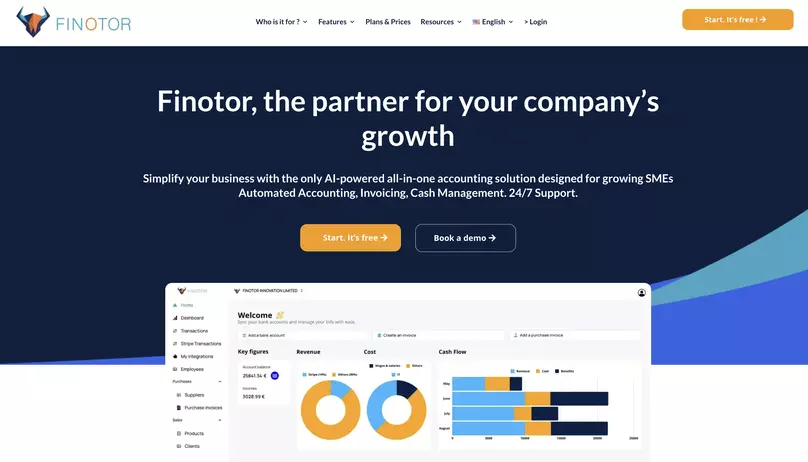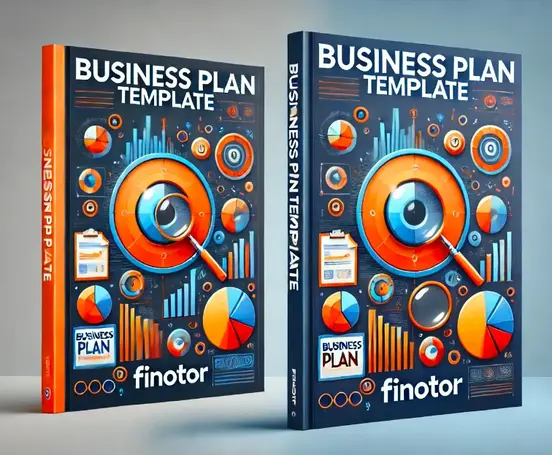Contents
Finotor vs Xero: which accounting software should you choose for your business?
Are you looking for an alternative to Finotor or Xero for your financial management? 🧐 Choosing the right accounting software can make all the difference to the efficiency of your business, especially when it comes to automating repetitive tasks. Our detailed comparison between these two popular solutions helps you decide which one best meets the needs of your company, whether it’s small or growing. Find out how these tools differ in terms of artificial intelligence, integration with Stripe and customer support to make an informed choice.
Contents
- Summary of our Finotor vs Xero comparison
- Finotor and Xero features
- Finotor vs Xero: what are the price differences?
- Customer reviews
- Should I buy Finotor or Xero?
Summary of our Finotor vs Xero comparison
Finotor is an AI-based accounting solution designed for growing SMEs. 💼 This software stands out for its advanced automation of tasks such as invoicing, cash management and expense reports. For example, an e-commerce entrepreneur can save several hours a month thanks to automated bank reconciliation. Xero, meanwhile, is online accounting software popular with small businesses and the self-employed. 🌟 It offers solid functionality for managing day-to-day finances and stands out for its ecosystem of connected applications (over 1,000 possible integrations). The main difference?
The technological approach! Finotor relies on artificial intelligence to automate and predict, while Xero excels in its network of integrations and ease of use. Julie, owner of an online shop, has cut her accounting management time by 40% thanks to Finotor automation. Both solutions are aimed at a variety of profiles: Finotor is particularly suited to fast-growing tech and e-commerce entrepreneurs, while Xero meets the needs of small businesses in sectors such as agriculture, construction and education.
Finotor and Xero features
| Features | Finotor | Xero |
|---|---|---|
| Accounting | Complete AI-based solution | Online accounting software |
| Target audience | Small businesses, entrepreneurs, freelancers, accountants, finance teams, e-commerce | Not specified in the data provided |
| Banking integration | Seamless integration for real-time transactions | Seamless integration for real-time transactions |
| Invoicing | Creation of recurring invoices and payment reminders | Invoice creation |
| AI and Automation | Improved financial forecasting, task automation, AI dedicated to accounting | AI integration for efficiency and accuracy |
| Data analysis | AI analysis to identify trends and anomalies | AI analysis to identify trends and anomalies |
| E-commerce specificity | Stripe and WooCommerce automation, eliminating duplicate entries | Not specified in the data supplied |
| Management | Invoice and payment management, real-time cash flow, full financial reporting | Inventory, multi-site monitoring, cost evaluation |
The table above highlights the main differences between the two accounting packages. Finotor and Xero offer similar functionality for accounts receivable and payable, online invoicing and bank reconciliation. However, Finotor stands out for its AI, which is particularly useful for automating repetitive tasks. 🤖 Xero, meanwhile, shines through its vast ecosystem of integrations with more than 1,000 third-party applications, offering great flexibility.
To ease the transition, Finotor offers an import tool to quickly migrate data from Xero. This solution is particularly popular with entrepreneurs like Sarah, who runs an online shop and was able to transfer her entire invoice history in just a few clicks. Finotor’s automation features are specifically designed for e-commerce businesses, thanks to its seamless integration with Stripe. This integration considerably simplifies bank reconciliation and saves a significant amount of time. 🕒 For its part,
Xero stands out for its traditional financial management tools, which have proved their worth with many small businesses. The user experience also varies between the two platforms. Finotor focuses on simplicity and efficiency through automation, while Xero offers an intuitive interface with a wide range of customisation options. For growing SMEs looking to optimise their financial management, the choice will mainly depend on their specific needs in terms of automation and integrations.
Artificial intelligence at the heart of Finotor
Finotor automates tasks and provides predictive analysis. 🧠 This technology transforms companies’ financial management by automating repetitive tasks and providing accurate predictive analyses. For an entrepreneur like Marc, owner of a web agency, this represents a daily saving of almost an hour on his administrative tasks. Finotor’s AI enables automated bank reconciliation, considerably reducing the time spent manually matching transactions. It also analyses financial trends to help anticipate cash flows and make informed decisions. This proactive approach gives businesses a competitive edge in their day-to-day management. The system uses advanced neural networks that continuously learn from your company’s financial data. The more you use Finotor, the more accurate the AI becomes in its predictions and automations. This continuous learning capability is a major advantage over traditional accounting solutions.
- Automated bank reconciliation: Finotor’s AI automates bank reconciliation, significantly reducing the time and effort required for this task, and minimising potential errors.
- Predictive analysis: Finotor offers predictive analysis, enabling companies to anticipate financial trends and make informed decisions to better manage their finances.
- AI agents for accounting: Finotor offers AI agents capable of answering questions on accounting codes, providing instant support and improving understanding of financial processes.
- Automatic audits: Finotor performs automatic quarterly audits to identify anomalies and ensure compliance, ensuring rigorous and secure financial management.
- Automatic cash management: Finotor offers automatic cash management with AI-based analysis and recommendations, enabling cash flow optimisation and better financial decision-making.
Xero’s ecosystem of integrations
Xero boasts an impressive ecosystem of over 1,000 connected third-party applications. 🔄 This wealth of integrations enables businesses to create a customised working environment that perfectly meets their specific needs. Julie, owner of a consultancy firm, was able to connect her CRM, project management tool and invoicing solution in just a few minutes. These integrations cover a wide range of areas such as employee management, payments, customer relations, project management and inventory. You can also find specific tools for certain sectors, such as retail, hospitality or construction.
This flexibility means that Xero can be adapted to virtually any type of business. The major advantage of this ecosystem is the fluidity of data between the different applications. Changes made in one application are automatically reflected in Xero and vice versa, guaranteeing consistency of information and limiting data entry errors. For companies already using several tools, this ability to integrate is a considerable advantage.
Finotor’s Stripe integration: an advantage for e-commerce
Finotor’s integration with Stripe offers a particularly effective solution for e-commerce businesses. 🛒 This system enables bank reconciliation of online payments to be fully automated, eliminating tedious manual operations. Thomas, founder of an online clothing shop, has cut the time he spends on his accounts by 80% thanks to this functionality. Thanks to this integration, sales details, customer information and product data are automatically recorded in Finotor as soon as a transaction is carried out on Stripe.
Refunds and charges are also recorded without manual intervention, ensuring a complete and accurate view of your business. This automation not only saves valuable time, but also eliminates the data entry errors that are common when reconciling transactions manually. For an e-commerce business handling dozens or hundreds of transactions a day, the impact on operational efficiency is considerable.
Traditional accounting management with Xero
Xero excels in traditional accounting functionality with robust and proven tools. 📊 Its online invoicing solution allows professional invoices to be created and sent from any device. Sophie, a freelance consultant, particularly appreciates the simplicity of the process, which allows her to send invoices directly from her smartphone while on the move. Xero’s bank reconciliation system, although less automated than Finotor’s, is still efficient and reliable. It connects bank accounts to automatically import transactions, making financial monitoring much easier. Users can then manually link these transactions to invoices and other accounting operations. The financial reports generated by Xero offer a clear and detailed view of the company’s financial health. Income statements, balance sheets, cash flows – all these important documents are easily accessible and customisable to your specific needs. This financial transparency is a major asset for strategic decision-making. Free Plan with Finotor
Finotor vs Xero: what are the price differences?
| Aspect | Finotor | Xero |
|---|---|---|
| Pricing | From €19.00/month | From US$20/month |
| Free trial | Available | 30 days free |
| Capterra Reviews | No reviews available | 4,4/5 (3 152 reviews) |
| Plans available | STARTER (free), LITE, BUSINESS, SUPER BUSINESS | Not specified |
| Customer support | Priority support for paying plans | Support score 4.0/5 |
Let’s take a closer look at the pricing options for these two accounting software packages. 💰 Finotor offers an entry-level plan at £19 per month, slightly cheaper than Xero which starts at around US$20. This may seem like a small difference, but it adds up over a full year of use for your business. Both platforms offer free trial periods, allowing professionals to test the interface before making a financial commitment.
Finotor’s advantage lies in its more flexible pricing structure with a totally free STARTER plan, ideal for freelancers just starting out. 🚀 For example, a freelance graphic designer can use the basic features free of charge for the first few months of their business. On the other hand, Xero benefits from a better reputation established on review platforms, with over 3,000 positive reviews on Capterra. The savings generated by Finotor’s automation are an often overlooked factor in cost comparisons. ⏱️ By reducing the time spent on accounting tasks, companies can make significant savings. Finotor’s integrated big data analysis typically reduces operational costs by 10-20%, according to feedback from users in a range of industries.
This optimisation can be seen in concrete terms for small companies. For example, an online shop that processes 500 transactions a month can save up to 5 hours a week by automating bank reconciliation. At an average hourly rate of €50 for an accountant, this represents a monthly saving of around €1,000 – much more than the cost of the subscription. The software’s return on investment improves considerably with Finotor’s artificial intelligence. 📊 Automating repetitive tasks such as categorising expenses or generating reports allows finance teams to focus on strategic analysis rather than data entry. For a medium-sized business, this can mean a better understanding of its customer lifetime value and therefore more relevant decisions.
Go for the FREE Plan with FINOTOR
Customer reviews
User reviews offer valuable insight into the actual experience with these accounting software packages. 📊 On Capterra, Xero stands out with an impressive rating of 4.4/5 based on over 3,152 reviews. This platform is particularly renowned for its ease of use and accounting features. Finotor, being a more recent solution on the market, does not yet have any reviews on Capterra. This can be an obstacle for companies that value feedback.
This lack of visibility on the quality of customer service and support may influence your choice. Finotor users particularly appreciate the artificial intelligence built into the service. 🤖 Pierre, manager of an online shop, says that automating bank reconciliation saves him almost 5 hours a week. Integration with Stripe is also often mentioned as a major advantage by e-commerce entrepreneurs. As for Xero, positive reviews highlight its ease of use and the breadth of its application ecosystem.
Marie, a freelance graphic designer, points out that“the connection with over 1,000 third-party applications means I can adapt the software perfectly to my specific needs”. Users also appreciate the quality of the financial dashboards. Criticisms of Finotor mainly concern the limited number of integrations available. 🔍 Some professionals also mention a greater learning curve to take full advantage of AI features. For Xero, the points for improvement mainly concern customer support and certain limitations in report customisation.
Should you buy Finotor or Xero?
Growing SMEs will find Finotor a valuable ally in automating their accounting. 🚀 Its artificial intelligence saves considerable time on repetitive tasks such as bank reconciliation. For example, a digital marketing company can halve the time spent entering financial data thanks to the automation offered by Finotor. E-commerce companies particularly benefit from Finotor’s integration with Stripe. 💳 This functionality eliminates double entry of transactions and ensures accurate accounting of online sales. An entrepreneur selling handcrafted products online can therefore focus on creation rather than managing payments. For Irish small businesses,
Finotor offers a tailored accounting solution that meets local requirements while providing an intuitive user experience. Freelancers and smaller organisations will appreciate Xero more for its extensive ecosystem of applications. 🔄 With over 1,000 possible integrations, this software adapts to a variety of business sectors. For example, a freelance consultant can connect Xero to their existing project management and invoicing tools. Companies needing a simple, comprehensive accounting solution will find Xero an effective tool. Its user-friendly interface means that even accounting novices can manage their finances with ease. Small family businesses can easily monitor cash flow and generate financial reports.
If you’re currently using Xero and thinking of switching to Finotor, read our guide to migrating from Xero to Finotor. The choice between these two solutions mainly depends on your priorities. 🎯 The size of your business, your sector of activity and your automation needs greatly influence this decision. Fast-growing companies with a need for intelligent automation will naturally lean towards Finotor. Smaller organisations looking for a tried-and-tested solution with numerous integrations will prefer Xero. Budget also plays a role in this decision. Although both software packages offer competitive prices, the investment needs to be weighed up against the functionality offered and the time saved. A small local business may find Finotor’s basic plan at €19/month cheaper than a Xero subscription with equivalent functionality.
Here are the decision-making criteria to help you choose between Finotor and Xero, depending on the specific needs of your business.
- Company size: If you’re a growing SME or start-up, Finotor could be the ideal choice thanks to its AI and automation features. For small businesses and freelancers, Xero offers an extensive ecosystem of applications and simplified accounting management.
- Industry: E-commerce businesses will particularly benefit from Finotor’s integration with Stripe, which simplifies bank reconciliation and online payment management. Xero is suitable for a wide range of sectors, including agriculture, construction, education, healthcare and hospitality.
- Automation and AI needs: If automating accounting tasks and predictive analytics are priorities, Finotor is the obvious choice thanks to its built-in AI. Xero offers automation capabilities, but focuses more on providing a wide range of financial management tools.
- Available budget: Finotor offers competitive pricing plans, with a starting price of €19/month, which can be advantageous for budget-conscious businesses. Xero also offers subscriptions from US$20 per month, but it’s important to compare the features included in each plan to determine which solution is most cost-effective.
- Level of accounting expertise: If you’re looking for a simple, intuitive solution, Xero might be more suitable, especially if you have little accounting experience. Finotor, with its built-in AI, may require some familiarity with the concepts of automation and predictive analysis.
Free Plan with Finotor The choice depends on your business priorities. 💼 Growing SMEs and e-tailers will appreciate Finotor’s AI-powered automation to save time on their accounting tasks. Smaller organisations and freelancers may prefer Xero’s extensive ecosystem of applications. In any case, these two accounting software alternatives offer reliable solutions for optimising your day-to-day financial management. Assess your size, sector and specific needs before making your choice – your financial peace of mind depends on it.
FAQ
What are the security features of Finotor and Xero?
Finotor is distinguished by its use of blockchain, which enhances data security and audit transparency. Imagine each transaction as a brick in an unalterable chain, making fraud more difficult to carry out. 🛡️ Xero, as cloud-based software, offers greater flexibility and accessibility. Automatic updates ensure that security is always up to date, protecting your company’s financial information. ☁️
How do I export data from Finotor or Xero?
With Finotor, you can easily export and import your data using CSV files. Simple and efficient, ideal for migrating your accounting information without hassle. ✅ Xero offers several export options depending on the type of data: trial balance, general ledger or subsidiary ledgers (customer and supplier). Each type of data has its own export method, often in Excel or CSV format, for maximum flexibility. 🗂️
What training options are available for Finotor and Xero?
Finotor relies on online resources such as its blog, offering articles on entrepreneurship and practical tools such as a free business plan template. A real helping hand to structure your ideas and convince investors. 💡 Xero offers tutorial videos to help you master the basics of the software, as well as accounting and business planning services. Enough to guide you step by step through using Xero. 🧑🏫
Do Finotor and Xero offer a mobile application?
Yes, they do! Finotor offers a mobile application that lets you view and send documents relating to purchases and sales. Manage your accounts on the move, wherever you are. 🚀 Xero also offers a mobile app called Xero Accounting, ideal for tracking cash flow, issuing invoices and managing expenses. Keep an eye on the financial health of your business from your smartphone. 📱
What are the alternatives to Finotor and Xero?
The market is full of alternatives to Finotor and Xero, each with its own specific features. Among the most popular are QuickBooks Online, FreshBooks, and Odoo. A variety of options to meet the needs of every business. 🌟 Other alternatives include Axonaut, EBP Comptabilité, and Pennylane, offering accounting functionality integrated with project management and CRM tools. Take the time to compare to find the ideal solution. 🧐
How can I contact Finotor and Xero customer support?
For Finotor, you can access the online help centre, benefit from 24/7 online support, or send an email to info@finotor.com. Full support to answer all your questions. 📧 Xero offers Xero Central, 24/7 online support, and a contact form to reach the support team by email. Please note that Xero does not publish a customer support telephone number to avoid scams. 🛡️









